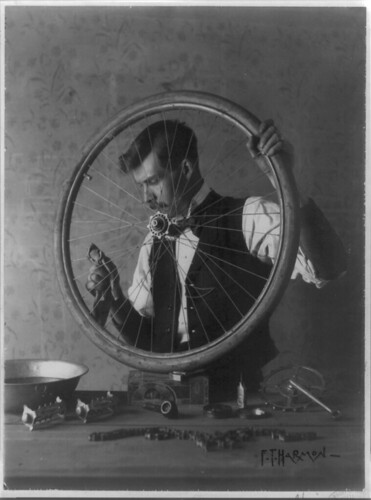
Title: Paying for his fun
Summary-Man working on bicycle wheel.
Created / Published- [between 1890 and 1899]
Subject Headings
- Bicycles & tricycles--1890-1900
- Wheels--1890-1900
- Cleaning--1890-1900
Format Headings-Photographic prints--1890-1900.
Notes-Copyright by F.T. Harmon.
Medium-1 photographic print.
Call Number/Physical Repository-Library of Congress Prints and Photographs Division Washington, D.C. 20540 USA
www.loc.gov/item/97511391/
It is a somewhat amusing notion reflected in this photograph from the 1890s that the bicycle rider "pays" for his fun - riding the bike - by spending time fixing the bike. Of course in the 1890s bikes were manufactured with lower tolerances and for a given amount of riding I would assume more repairs were required than for a good quality bike made today.
Still, for the most part I find working on my bikes to be relaxing, although I mostly do fairly basic stuff. I don't do anything with bottom brackets, headsets, or truing wheels. (I guess some people might say that doesn't leave much . . . )
Recently I had a little crash - I managed to end up with both the front and rear wheels out of true on the bike I was riding. I noticed the problem with the rear wheel immediately and got it fixed but it took me a while to realize the front wheel was a bit off - then I had it fixed also.
For me, paying someone to do certain repairs is better than the aggravation/frustration of trying to do it myself without having the right tools or much experience. I'm quite lucky since there is a shop about a mile away, Spokes Etc, where there is a dedicated wheel builder and "wheel mechanic", Bill Mould, who for 20 dollars will correct any true a wheel, putting in in one plane but also making sure it is still round.
